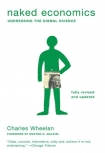Naked Economics by Wheelan, Charles (spanish books to read .txt) 📕

Read free book «Naked Economics by Wheelan, Charles (spanish books to read .txt) 📕» - read online or download for free at americanlibrarybooks.com
Read book online «Naked Economics by Wheelan, Charles (spanish books to read .txt) 📕». Author - Wheelan, Charles
The phrase “somewhere in the range” gives you the first inkling of how hard the Fed’s job is. The Federal Reserve must strike a delicate balance. If the economy grows more slowly than it is capable of, then we are wasting economic potential. Plants that make PT Cruisers sit idle; the workers who might have jobs there are unemployed instead. An economy that has the capacity to grow at 3 percent instead limps along at 1.5 percent, or even slips into recession. Thus, the Fed must feed enough credit to the economy to create jobs and prosperity but not so much that the economy begins to overheat. William McChesney Martin, Jr., Federal Reserve chairman during the 1950s and 1960s, once noted that the Fed’s job is to take away the punch bowl just as the party gets going.
Or sometimes the Fed must rein in the party long after it has gone out of control. The Federal Reserve has deliberately engineered a number of recessions in order to squeeze inflation out of the system. Most notably, Fed chairman Paul Volcker was the ogre who ended the inflationary party of the 1970s. At that point, naked people were dancing wildly on the tables. Inflation had climbed from 3 percent in 1972 to 13.5 percent in 1980. Mr. Volcker hit the monetary brakes, meaning that he cranked up interest rates to slow the economy down. Short-term interest rates peaked at over 16 percent in 1981. The result was a painful unwinding of the inflationary cycle. With interest rates in double digits, there were plenty of unsold Chrysler K cars sitting on the lot. Dealers were forced to cut prices (or stop raising them). The auto companies idled plants and laid off workers. The autoworkers who still had jobs decided that it would be a bad time to ask for more money.
The same thing, of course, was going on in every other sector of the economy. Slowly, and at great human cost, the expectation that prices would steadily rise was purged from the system. The result was the recession of 1981–1982, during which GDP shrank by 3 percent and unemployment climbed to nearly 10 percent. In the end, Mr. Volcker did clear the dancers off the tables. By 1983, inflation had fallen to 3 percent. Obviously it would have been easier and less painful if the party had never gone out of control in the first place.
Where does the Fed derive this extraordinary power over interest rates? After all, commercial banks are private entities. The Federal Reserve cannot force Citibank to raise or lower the rates it charges consumers for auto loans and home mortgages. Rather, the process is indirect. Recall from Chapter 7 that the interest rate is really just a rental rate for capital, or the “price of money.” The Fed controls America’s money supply. We’ll get to the mechanics of that process in a moment. For now, recognize that capital is no different from apartments: The greater the supply, the cheaper the rent. The Fed moves interest rates by making changes in the quantity of funds available to commercial banks. If banks are awash with money, then interest rates must be relatively low to attract borrowers for all the available funds. When capital is scarce, the opposite will be true: Banks can charge higher interest rates and still attract enough borrowers for all available funds. It’s supply and demand, with the Fed controlling the supply.
These monetary decisions—the determination whether interest rates need to go up, down, or stay the same—are made by a committee within the Fed called the Federal Open Market Committee (FOMC), which consists of the board of governors, the president of the Federal Reserve Bank of New York, and the presidents of four other Federal Reserve Banks on a rotating basis. The Fed chairman is also the chairman of the FOMC. Ben Bernanke derives his power from the fact that he is sitting at the head of the table when the FOMC makes interest rate decisions.
If the FOMC wants to stimulate the economy by lowering the cost of borrowing, the committee has two primary tools at its disposal. The first is the discount rate, which is the interest rate at which commercial banks can borrow funds directly from the Federal Reserve. The relationship between the discount rate and the cost of borrowing at Citibank is straightforward; when the discount rate falls, banks can borrow more cheaply from the Fed and therefore lend more cheaply to their customers. There is one complication. Borrowing directly from the Fed carries a certain stigma; it implies that a bank was not able to raise funds privately. Thus, turning to the Fed for a loan is similar to borrowing from your parents after about age twenty-five: You’ll get the money, but it’s better to look somewhere else first.
Instead, banks generally borrow from other banks. The second important tool in the Fed’s money supply





Comments (0)